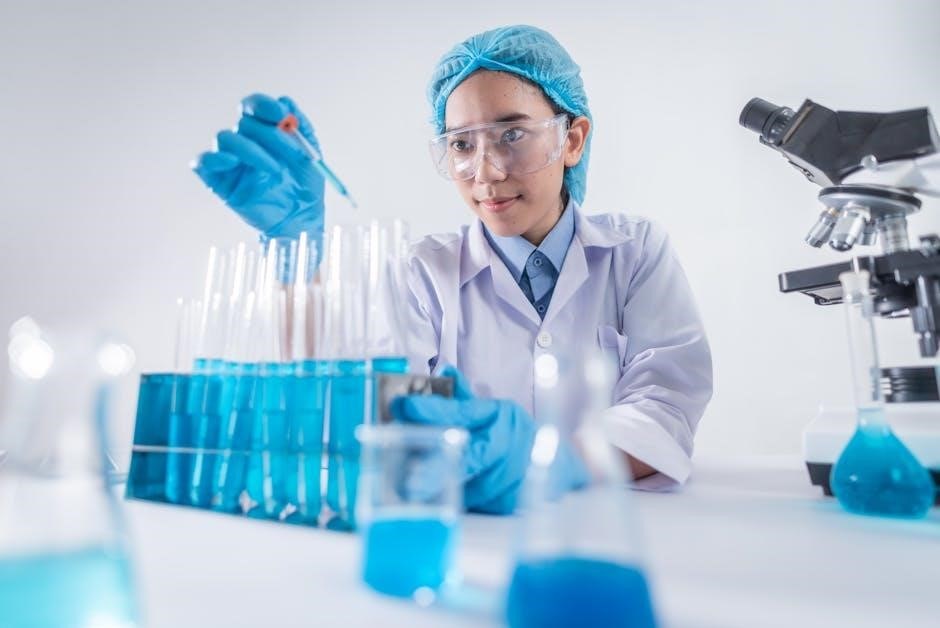This lab manual serves as a comprehensive guide for conducting general chemistry experiments, outlining procedures, safety protocols, and best practices for a successful laboratory experience․
1․1․ Purpose and Scope of the Manual
The purpose of this lab manual is to provide students with a structured and comprehensive guide for conducting general chemistry experiments․ It outlines essential procedures, safety protocols, and best practices to ensure a safe and effective learning environment․ The scope of the manual covers a wide range of topics, including introductory experiments, quantitative and qualitative analyses, and advanced techniques such as titration and chromatography․ It also emphasizes the development of critical skills in data recording, calculations, and error analysis․ The manual serves as a reference for understanding lab equipment, handling chemicals, and following proper disposal methods․ Additionally, it includes resources for further learning, such as recommended textbooks and online tools, to support students in mastering chemistry concepts․ By following this manual, students will gain hands-on experience and a deeper understanding of chemical principles and laboratory practices․
1․2․ Lab Objectives and Expectations
The primary objective of the lab is to provide students with hands-on experience in applying chemical principles to real-world experiments․ By participating in lab activities, students are expected to develop proficiency in using laboratory equipment, such as micropipettes and spectrometers, and in performing techniques like titration and chromatography․ They will also gain skills in data collection, analysis, and interpretation, which are essential for scientific inquiry; Additionally, students are expected to adhere to safety protocols, properly handle and dispose of chemicals, and maintain a clean and organized workspace․ Regular attendance, active participation, and thorough preparation for each lab session are required to meet the expectations․ The ultimate goal is for students to become confident in their ability to design and execute experiments, think critically, and communicate their findings effectively through lab reports and presentations․
1․3․ Safety Guidelines and Regulations
Safety is paramount in the chemistry lab, and all students must adhere to established guidelines to minimize risks․ Personal protective equipment (PPE), such as goggles, gloves, and lab coats, must be worn at all times․ Familiarity with emergency equipment, including fire extinguishers, eyewash stations, and safety showers, is essential․ Chemicals should be handled with care, and their Safety Data Sheets (SDS) must be reviewed before use․ Unauthorized experiments are strictly prohibited, and all waste must be disposed of according to laboratory regulations․ Eating, drinking, and using electronic devices unrelated to the lab are not permitted․ Students are responsible for cleaning their workstations and reporting any accidents or spills immediately․ Failure to follow safety protocols may result in disciplinary action․ Always prioritize caution and ensure a safe environment for yourself and others․

Safety in the Chemistry Lab
Safety in the chemistry lab is crucial․ Always wear appropriate PPE, know emergency procedures, and handle chemicals properly․ Familiarize yourself with equipment and follow all regulations to ensure a secure environment․
2․1․ Personal Protective Equipment (PPE)
Personal Protective Equipment (PPE) is essential for safeguarding against hazards in the chemistry lab․ Common PPE includes lab coats, gloves, goggles, and closed-toe shoes․ Lab coats protect clothing from chemical splashes, while gloves prevent skin contact with harmful substances․ Goggles or safety glasses with chemical-resistant lenses shield the eyes from splashes or broken glass․ Closed-toe shoes protect feet from dropped objects or spills․ Additionally, hair should be tied back, and jewelry avoided to prevent entanglement or exposure to chemicals․ It is crucial to select the appropriate type of gloves based on the chemical being handled, as not all gloves are resistant to every substance․ PPE must be worn correctly and removed properly to avoid contamination․ Remember, PPE is not optional; it is mandatory for participation in lab activities․ Always ensure PPE is in good condition and suitable for the specific experiment being conducted․
2․2․ Emergency Procedures and Equipment
In case of emergencies, knowing the proper procedures and having the right equipment is critical․ Fire extinguishers, specifically multipurpose ABC extinguishers, are essential for combating chemical fires․ Eye wash stations and safety showers should be easily accessible to flush out chemicals or cool burns․ Spill control kits, including absorbent materials and neutralizing agents, are vital for containing and managing chemical spills․ In case of exposure, immediately flush the affected area with water for at least 15 seconds․ For fires, evacuate the area, pull the fire alarm, and use extinguishers only if trained․ Familiarize yourself with the location of emergency exits and equipment before starting any experiment․ Always follow evacuation procedures and assemble at a designated safe area․ Regular drills and training ensure preparedness for emergencies, minimizing risks and ensuring a swift response․ Remember, safety is everyone’s responsibility in the lab․
2․3․ Handling and Disposal of Chemicals
Proper handling and disposal of chemicals are crucial for maintaining a safe laboratory environment․ Always wear appropriate PPE, such as gloves and goggles, when handling chemicals․ Use tongs or heat-resistant gloves for hot objects and avoid direct contact with chemicals․ Label all containers clearly, and ensure chemicals are stored in their designated areas․ For disposal, segregate waste into organic, inorganic, and hazardous categories․ Use designated containers for broken glassware and sharps․ Neutralize acids or bases with appropriate substances before disposal, and never pour chemicals down drains unless instructed․ Dispose of hazardous waste according to local regulations and consult Safety Data Sheets (SDS) for specific guidance․ Proper disposal prevents environmental contamination and ensures compliance with safety protocols․
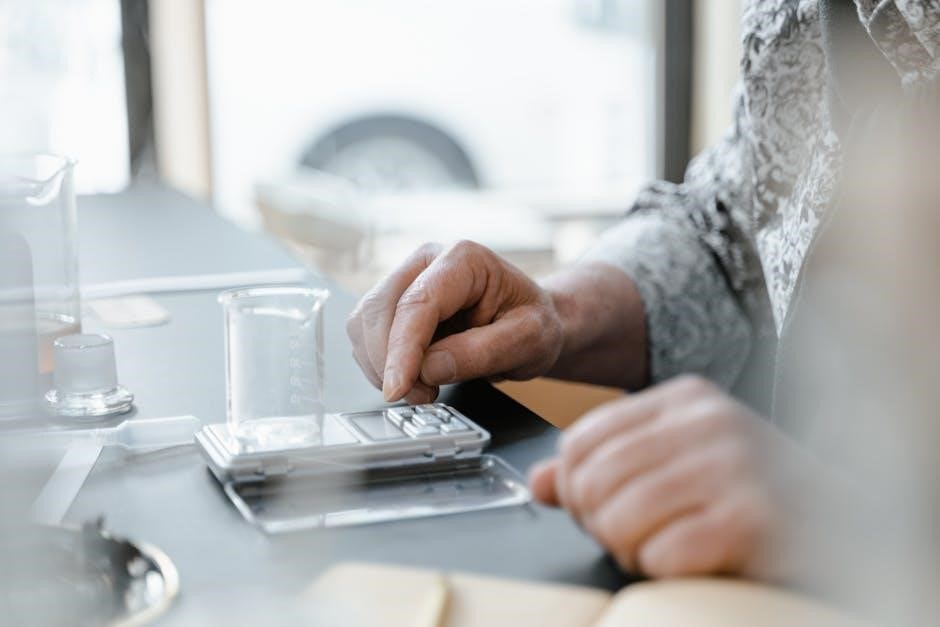
Materials and Equipment
This section outlines the essential materials and equipment required for general chemistry experiments, including common instruments, measurement tools, and specialized devices for advanced procedures․
3․1․ Common Lab Instruments and Their Uses
In a general chemistry lab, common instruments include Bunsen burners, test tube holders, pipettes, burettes, and volumetric flasks․ These tools are essential for heating, measuring, and mixing chemical solutions․ Bunsen burners provide a controlled flame for heating substances, while test tube holders safely handle hot glassware․ Pipettes and burettes are used for precise liquid measurements, crucial in titrations and stoichiometric calculations․ Volumetric flasks ensure accurate solution preparation․ Other instruments like thermometers, balances, and stirring rods are also frequently used․ Understanding the proper use of these instruments is vital for conducting experiments safely and effectively, ensuring accurate results and adherence to laboratory protocols․ These tools form the foundation of laboratory operations, enabling students to perform a wide range of chemical experiments and analyses․ Proper care and maintenance of these instruments are essential to prolong their utility and performance․
3․2․ Measurement Tools (Pipettes, Burettes, etc․)
In a general chemistry lab, precise measurements are critical, and tools like pipettes, burettes, and volumetric flasks are indispensable․ Pipettes, including transfer and measuring types, are used to accurately transfer or measure small volumes of liquids․ Burettes, with their graduated scales, are essential for titrations, allowing precise delivery of solutions․ Volumetric flasks ensure accurate dilutions, while measuring cylinders and graduated transfer pipettes offer versatility for various tasks․ Each tool requires proper technique, such as reading meniscus levels and avoiding contamination․ Regular calibration and maintenance are crucial to ensure accuracy․ These instruments are fundamental for quantitative experiments, enabling precise molarity calculations and stoichiometric analyses․ Mastery of their use is vital for achieving reliable and reproducible results in chemical experiments․ Proper handling and storage prolong their functionality, making them essential assets in any chemistry laboratory setting․
3․3․ Specialized Equipment for Advanced Experiments
Advanced chemistry experiments often require specialized equipment to achieve precise results․ Tools like spectrophotometers are used for analyzing light absorption, aiding in concentration determination․ Chromatography equipment, such as gas or liquid chromatographs, separates and identifies components in mixtures․ Titration systems, including automatic titrators, enhance accuracy in acid-base reactions․ Vacuum pumps and rotary evaporators are essential for distillation and solvent removal․ Additionally, equipment like gloveboxes or inert atmosphere chambers is used for handling air-sensitive compounds․ These advanced tools enable complex analyses, such as determining molecular structures or studying reaction kinetics․ Proper training and understanding of their operation are crucial for safe and effective use․ Specialized equipment expands the scope of experiments, allowing for deeper exploration of chemical principles and phenomena․ Regular maintenance ensures optimal performance and longevity of these precision instruments․
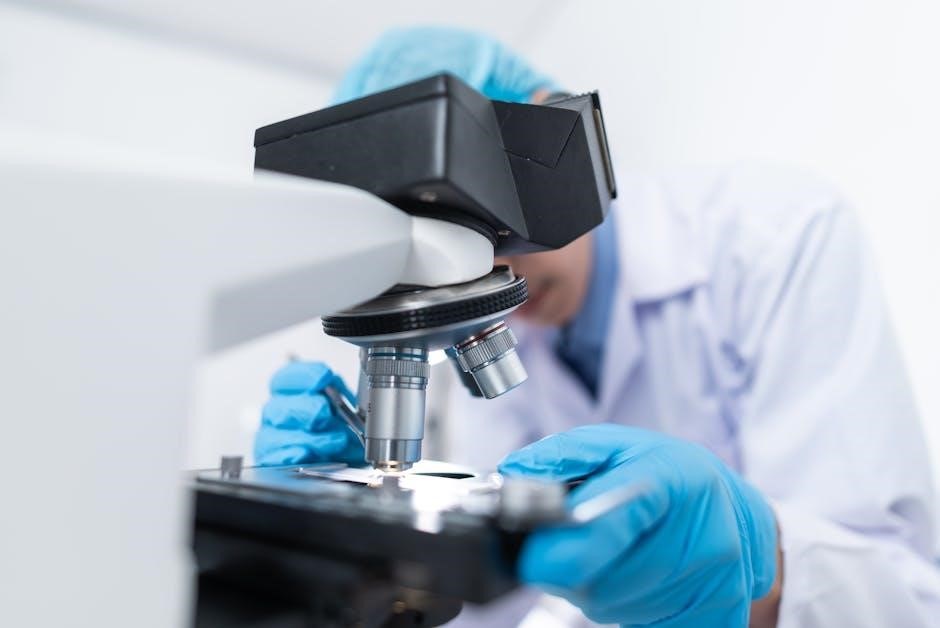
Laboratory Techniques
Laboratory techniques are essential for conducting experiments and understanding chemical principles․ They include methods for accurate measurements, separations, and analyses, ensuring reliable and reproducible results in various experiments․
4․1․ Basic Techniques: Measurement, Mixing, and Heating
Mastering basic laboratory techniques is fundamental for successful experiments․ Measurement involves accurately quantifying substances using tools like balances, pipettes, and burettes․ Mixing ensures uniformity in solutions, often requiring gentle stirring or shaking․ Heating is critical for reactions, employing heat sources such as Bunsen burners or hot plates․ Proper techniques prevent contamination and ensure safety․ Always calibrate instruments and use appropriate glassware to avoid errors․ When heating, monitor temperatures closely to control reactions․ Safety precautions, like wearing gloves and goggles, are essential․ These foundational skills are vital for precise and reliable outcomes in chemistry experiments․
4․2․ Advanced Techniques: Titration, Filtration, and Distillation
Advanced laboratory techniques are essential for precise chemical analysis and purification․ Titration involves measuring the concentration of a solution by reacting it with a standard solution of known concentration, commonly used in acid-base reactions․ Filtration separates solids from liquids using filter paper or membranes, ensuring pure samples for further analysis․ Distillation purifies substances based on differences in boiling points, isolating components of a mixture․ These methods require careful calibration, accurate measurements, and attention to detail to ensure reliable results․ Proper execution of these techniques is critical for achieving accurate data and maintaining the integrity of experiments․ Mastery of titration, filtration, and distillation is fundamental for advancing in chemistry and conducting complex analyses effectively․
4․3․ Specialized Techniques: Chromatography and Spectroscopy
Chromatography and spectroscopy are advanced analytical techniques used to separate, identify, and quantify chemical compounds․ Chromatography separates components of a mixture based on their interaction with a stationary phase and a mobile phase, commonly used in thin-layer, gas, or liquid chromatography․ Spectroscopy involves analyzing the interaction of matter with electromagnetic radiation, such as UV-Vis or infrared spectroscopy, to determine molecular structures and concentrations․ These methods are essential for identifying unknown substances, assessing purity, and elucidating molecular structures․ Chromatography is particularly useful for separating complex mixtures, while spectroscopy provides detailed information about chemical bonding and composition․ Together, these techniques are indispensable in modern chemistry for precise analysis and characterization of substances in various fields, from pharmaceuticals to environmental science․

Common Laboratory Experiments
Common lab experiments include acid-base titrations, stoichiometry verification, and identifying substances․ These experiments help students master chemical reactions, quantitative analysis, and analytical techniques in a hands-on environment․
5․1․ Introductory Experiments: Chemical Reactions and Stoichiometry
Introductory experiments focus on fundamental chemical reactions and stoichiometry, enabling students to understand the principles of chemical interactions and quantitative relationships․ These experiments include synthesizing compounds, analyzing reaction stoichiometry, and verifying chemical equations․ Students learn to predict products, balance equations, and calculate molar ratios․ Hands-on activities, such as measuring reactants and observing reaction outcomes, reinforce theoretical concepts․ Data recording and analysis are emphasized to develop accurate laboratory practices․ These experiments build foundational skills in laboratory techniques, chemical calculations, and critical thinking, preparing students for more complex experiments in subsequent sections․
5․2․ Quantitative Experiments: Acid-Base Titrations and Molarity Calculations
Quantitative experiments, such as acid-base titrations, are designed to refine students’ skills in precise measurement and chemical analysis․ These experiments focus on determining the concentration of acids or bases by reacting them with standardized solutions․ Students learn to use a burette accurately and calculate molarity using titration data․ Key concepts include stoichiometry, equivalence points, and the relationship between pH and ion concentration․ These experiments also introduce the importance of precise measurements and data interpretation․ By performing these exercises, students develop the ability to apply theoretical knowledge to practical problems, ensuring accurate and reliable results․ The experiments emphasize the application of mathematical skills, such as calculating dilution factors and determining ion concentrations, which are critical in quantitative chemistry․
5․3․ Qualitative Experiments: Identifying Substances and Analyzing Solutions
Qualitative experiments focus on identifying unknown substances and analyzing the composition of solutions․ These exercises help students develop observational and analytical skills, such as detecting chemical reactions, color changes, and precipitate formation․ Common techniques include chemical tests for ions, pH determination using indicators, and solubility analysis․ Students learn to use lab tools like test tubes, droppers, and spectrometers to gather data․ These experiments emphasize the importance of careful observation and accurate recording of results․ By identifying substances and their properties, students gain hands-on experience with chemical behavior and reactions․ This section builds foundational skills for advanced analytical chemistry, encouraging critical thinking and problem-solving in a practical setting․ The experiments are designed to enhance understanding of chemical interactions and their practical applications․
5․4․ Synthesis Experiments: Preparing Compounds and Analyzing Properties
Synthesis experiments involve the preparation of chemical compounds and the analysis of their physical and chemical properties․ These experiments teach students how to follow precise procedures to combine reactants, monitor reactions, and purify products․ Key steps include measuring reactants accurately, controlling reaction conditions, and isolating the final product․ Students learn various techniques such as filtration, recrystallization, and drying to obtain pure compounds․ The analysis phase involves determining properties like melting point, solubility, and color to confirm the identity and purity of the product․ These experiments emphasize stoichiometry, chemical equilibrium, and the importance of careful record-keeping․ By synthesizing compounds, students gain practical experience in chemical preparation and characterization, which are essential skills for advanced chemistry studies and research․ These exercises also highlight the connection between theoretical concepts and real-world applications in chemistry․
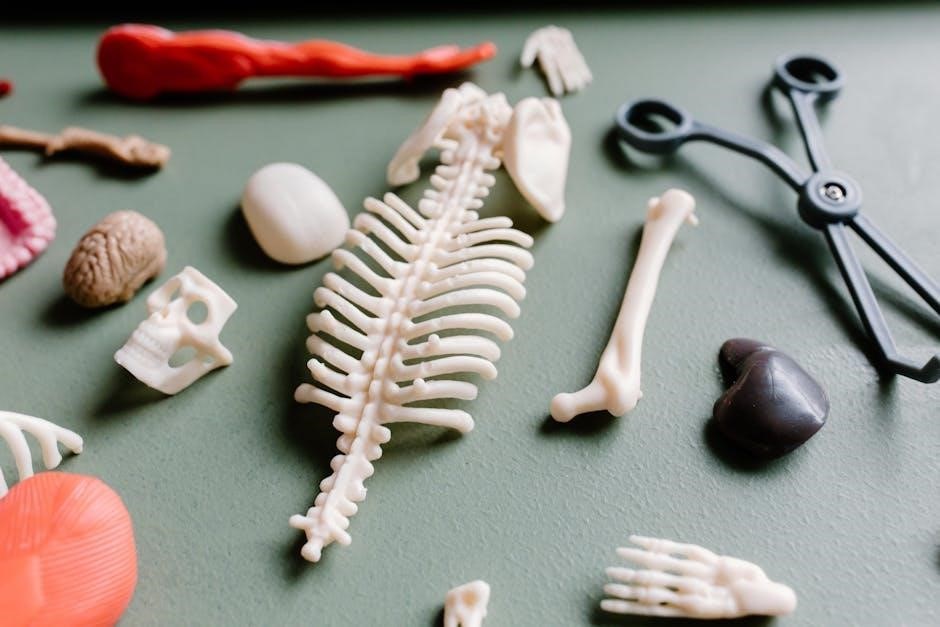
Data Analysis and Reporting
This section covers the essential steps for analyzing experimental data, performing accurate calculations, and effectively reporting results․ Proper documentation and interpretation are crucial for valid conclusions․
6․1․ Recording Data and Maintaining a Lab Notebook
Accurate and detailed recording of experimental data is essential for reliable results․ A well-maintained lab notebook serves as a legal and academic record of all lab activities․ Include dates, objectives, procedures, and observations․ Record raw data, calculations, and results clearly, using tables or graphs when appropriate․ Ensure all entries are legible, dated, and initialed․ Note any unexpected observations or errors, as these can provide valuable insights․ Use units consistently and highlight key findings․ Regularly review and update the notebook to maintain organization․ Proper documentation allows for reproducibility and verification of experiments․ Examples of data recording and notebook organization are provided in the manual to guide students in developing good habits․ Referencing previous entries helps in cross-checking results and improving experimental techniques․ Accurate record-keeping is a cornerstone of scientific integrity and ensures the validity of your work․
6․2․ Calculations and Error Analysis
Accurate calculations are crucial for interpreting experimental results․ Begin by carefully reviewing data to ensure accuracy before performing calculations․ Use proper unit conversions and significant figures to maintain precision․ Error analysis identifies discrepancies between experimental and theoretical results, helping to assess the reliability of data․ Common sources of error include measurement inaccuracies, equipment limitations, and procedural mistakes․ Conduct a thorough analysis to determine the root cause of errors and implement corrections․ Statistical methods, such as standard deviation and percent error, are used to quantify uncertainty․ Document all calculations and error analyses in your lab notebook, providing a clear explanation of methods and assumptions․ This process enhances understanding and improves future experiments․ Resources in the lab manual and online tools can assist with complex calculations and error interpretation, ensuring accurate and meaningful results․ Regular practice in error analysis strengthens problem-solving skills and attention to detail․
6․3․ Writing Lab Reports and Presenting Results
Writing clear and concise lab reports is essential for effectively communicating experimental findings․ A well-structured report typically includes a title, introduction, procedure, results, discussion, and conclusion․ The introduction outlines the experiment’s purpose and objectives, while the procedure details the steps taken․ Results are presented using tables, graphs, and descriptive text, avoiding interpretation․ In the discussion, analyze data, compare with theoretical expectations, and explain discrepancies․ The conclusion summarizes key findings and their implications․ Use proper formatting, citations, and appendices for supplementary data․ When presenting results, use visual aids like charts and graphs to enhance understanding․ Practice clear and confident communication, addressing questions and providing context․ Regularly review and edit reports to ensure accuracy and clarity, incorporating feedback to improve future submissions․ Refer to the lab manual for specific formatting guidelines and examples to ensure consistency and professionalism in your reports․
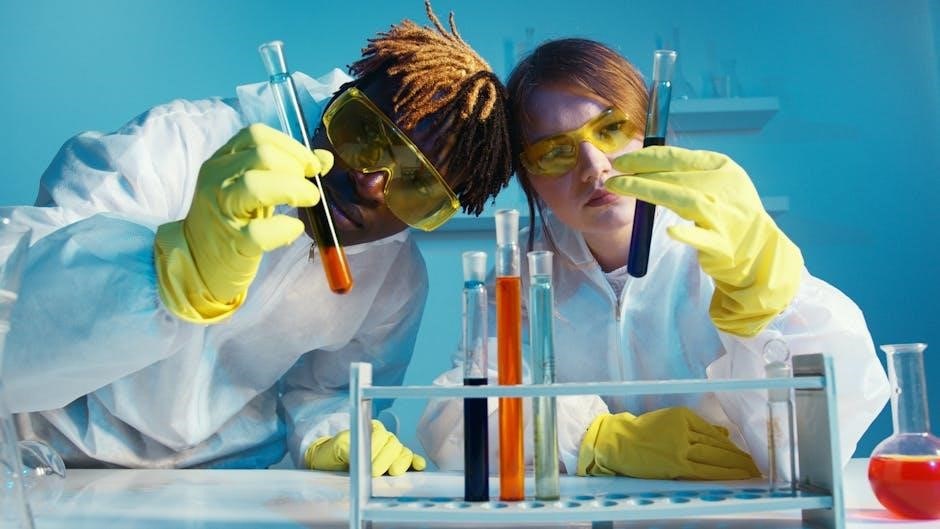
Resources and References
This section provides essential resources, including recommended textbooks, online materials, and safety data sheets․ Refer to the Laboratory Manual for General Chemistry and online platforms like PDFDrive․com for additional guidance and reference materials․
7․1․ Recommended Textbooks and Online Resources
For a comprehensive understanding of general chemistry, several textbooks are highly recommended, including Laboratory Manual for General Chemistry and supplementary materials from PDFDrive․com․ Online resources such as YouTube channels dedicated to chemistry lab tutorials and university websites offering interactive guides are invaluable․ These resources provide detailed procedures, theoretical explanations, and practical insights, ensuring students and educators have access to up-to-date information․ Utilizing these materials enhances both conceptual understanding and hands-on laboratory skills, making them essential for a successful learning experience in general chemistry․
7․2․ Lab Manuals and Experiment Guides
Laboratory manuals and experiment guides are essential resources for conducting general chemistry experiments․ These manuals typically include detailed procedures, safety protocols, and expected outcomes for each experiment․ For example, the Laboratory Manual for General Chemistry provides step-by-step instructions for experiments, ensuring students can follow along with ease․ Experiment guides often focus on specific techniques, such as titration or chromatography, and offer troubleshooting tips․ Many institutions, like Portland State University, provide digital access to these materials, making them accessible for pre-lab preparation․ Additionally, resources like PDFDrive․com offer downloadable lab manuals, which are useful for reference․ These guides not only enhance understanding but also ensure safe and efficient experimentation, making them indispensable for both students and educators․
7․3․ Safety Data Sheets (SDS) and Chemical Information
Safety Data Sheets (SDS) are critical resources for handling chemicals safely in a general chemistry lab․ These documents provide detailed information about a chemical’s properties, hazards, and safe handling practices․ SDS are organized into sections, including hazard identification, first aid measures, and disposal considerations․ They are essential for understanding how to respond to spills or exposure and for determining the proper personal protective equipment (PPE) needed․ Students and lab personnel should consult SDS before working with any chemical to ensure safe handling and compliance with regulations․ Many institutions provide access to SDS through online databases or chemical suppliers’ websites․ Proper use of SDS is a cornerstone of lab safety and supports a responsible and informed approach to working with chemicals․
